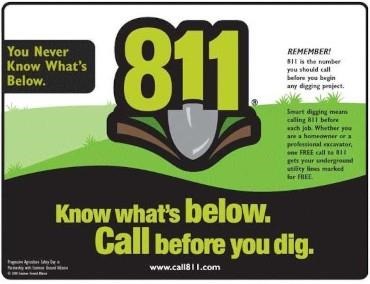By DeAnn Presley
With harvest complete and some mild temperatures heading into winter, farmers might take to the field for deep tillage such as ripping, or to make earthwork repairs around the farm. A few days before you want to start these activities, it’s worth a call to 811 for your safety and to prevent expensive damage to underground utilities. The website, http://call811.com, has easy-to-follow instructions for requesting this free service and detailed information concerning why you need to know what’s below.
A video produced by Marathon Oil tells the story of a farm family and their close-call with a pipeline when installing tile drains. The landowner knew where the pipeline entered and exited the field, and they assumed the pipeline was straight— it wasn’t. Watch this 6-minute, eye-opening video for the whole story; https://youtu.be/oe-iknpYzF8.
Sadly, fatal accidents do happen in soil excavations. If you dig any trenches or soil pits, safety should be considered from the very beginning of the project. Soils with sandy textures are more susceptible to a collapse than soils with a higher clay content. If standing water is present in the pit, the walls are more apt to collapse. Digging in soils that have been disturbed before, such as digging next to a hydrant or foundation, for example, means that the soil is far less stable than you might expect if that soil had never been disturbed before.
There are Occupational Safety and Health Administration (OSHA) guidelines on excavation safety, such as when it is necessary to shore the walls of a soil pit or trench. One important consideration is soil should be piled a minimum of 2 feet away from the walls of the trenches for two reasons:
- Soil clods or excavating tools could roll back into the trench and cause injury to occupants.
- Helps reduce the risk of a trench collapse by keeping the weight of the soil piles away from the trench edges.
Even if a soil pit is 5 feet deep or less, it is a good idea to angle the edges of the soil pit, especially if the texture is sandy, the soil is wet, or if the soil is otherwise unstable. This does create more disturbance, but if it prevents an accident, it’s worth it.

Source : ksu.edu